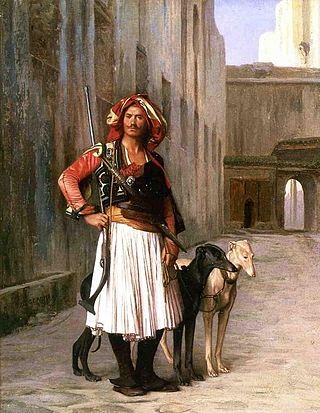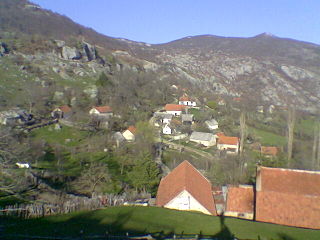
The Eastern Front or Eastern Theater, of World War I, was a theater of operations that encompassed at its greatest extent the entire frontier between Russia and Romania on one side and Austria-Hungary, Bulgaria, the Ottoman Empire, and Germany on the other. It ranged from the Baltic Sea in the north to the Black Sea in the south, involved most of Eastern Europe, and stretched deep into Central Europe. The term contrasts with the Western Front, which was being fought in Belgium and France. Unlike the static warfare on the Western Front, the fighting on the geographically larger Eastern Front was more dynamic, often involving the flanking and encirclement of entire formations, and resulted in over 100,000 square miles of territory becoming occupied by a foreign power.

Chercos is a municipality of Almería province, in the autonomous community of Andalusia, Spain. The original village lies about three kilometres south of modern-day Chercos, clinging to the side of the Sierra de los Filabres.

World War II in the Kingdom of Yugoslavia began on 6 April 1941, when the country was invaded and swiftly conquered by Axis forces and partitioned among Germany, Italy, Hungary, Bulgaria and their client regimes. Shortly after Germany attacked the USSR on 22 June 1941, the communist-led republican Yugoslav Partisans, on orders from Moscow, launched a guerrilla liberation war fighting against the Axis forces and their locally established puppet regimes, including the Axis-allied Independent State of Croatia (NDH) and the Government of National Salvation in the German-occupied territory of Serbia. This was dubbed the National Liberation War and Socialist Revolution in post-war Yugoslav communist historiography. Simultaneously, a multi-side civil war was waged between the Yugoslav communist Partisans, the Serbian royalist Chetniks, the Axis-allied Croatian Ustaše and Home Guard, Serbian Volunteer Corps and State Guard, Slovene Home Guard, as well as Nazi-allied Russian Protective Corps troops.
The Baćin massacre was the killing of 83 civilians just outside the village of Baćin, near Hrvatska Dubica, committed by Croatian Serb paramilitaries. The killings took place on 21 October 1991 during the Croatian War of Independence. Most of the civilians were Croats, but they also included two ethnic Serbs, taken from Hrvatska Dubica, Baćin and the nearby village of Cerovljani. The civilians were killed in the area of Krečane, at the very bank of the Una River, and their bodies were left unburied for two weeks. Most of them were subsequently bulldozed into a shallow mass grave, while a number of the bodies were thrown into the river. Further killings of Croat civilians continued in Baćin and surrounding areas until February 1992.
Operation Mistral 2, officially codenamed Operation Maestral 2, was a Croatian Army (HV) and Croatian Defence Council (HVO) offensive in western Bosnia and Herzegovina on 8–15 September 1995 as part of the Bosnian War. Its objective was to create a security buffer between Croatia and positions held by the Bosnian Serb Army of Republika Srpska (VRS). The operation also spearheaded a Herzeg-Croat led move to compromise the occupation of the largest Bosnian Serb-held city, Banja Luka, by capturing the towns of Jajce, Šipovo and Drvar. Thus jeopardizing the operations capacity of Banja Luka and ultimately leading to its recapture. The combined HV and HVO forces were under the overall command of HV Major General Ante Gotovina.

Arnaut is a Turkish ethnonym used to denote Albanians. Arvanid (اروانيد), Arnavud (آرناوود), plural: Arnavudlar (آرناوودلر): modern Turkish: Arnavut, plural: Arnavutlar; are ethnonyms used mainly by Ottoman and contemporary Turks for Albanians with Arnavutça being called the Albanian language. 'Albanian' (Arnavud) was one of the few ethnic markers normally used, besides the regular religious labels, for the identification of people in official record of the Ottoman state.

During the Bosnian War, there was an ethnic cleansing campaign committed by the Bosnian Serb political and military leadership – Army of the Republika Srpska, mostly against Bosniak and Croat civilians in the Prijedor region of Bosnia and Herzegovina in 1992 and 1993. The composition of non-Serbs was drastically reduced: out of a population of 50,000 Bosniaks and 6,000 Croats, only some 6,000 Bosniaks and 3,000 Croats remained in the municipality by the end of the war. Apart from the Srebrenica massacre, Prijedor is the area with the second highest rate of civilian killings committed during the Bosnian War. According to the Sarajevo-based Research and Documentation Center (IDC), 4,868 people were killed or went missing in the Prijedor municipality during the war. Among them were 3,515 Bosniak civilians, 186 Croat civilians and 78 Serb civilians. As of October 2013, 96 mass graves have been located and around 2,100 victims have been identified, largely by DNA analysis.

The St. Francis Raid was an attack in the French and Indian War by Robert Rogers on St. Francis, near the southern shore of the Saint Lawrence River in what was then the French province of Canada, on October 4, 1759. Rogers and about 140 men entered the village, which was reportedly occupied primarily by women, children, and the elderly, early that morning, slaughtered many of the inhabitants where they lay, shot down many who attempted to flee, and then burned the village. Rogers reported killing as many as 200 people, while French reports placed the number closer to thirty, mainly women and children. One of Rogers' men was killed, and seven were wounded.
The Gudovac massacre was the mass killing of around 190 Bjelovar Serbs by the Croatian nationalist Ustaše movement on 28 April 1941, during World War II. The massacre occurred shortly after the German-led Axis invasion of Yugoslavia and the establishment of the Ustaše-led Axis puppet state known as the Independent State of Croatia (NDH). It was the first act of mass murder committed by the Ustaše upon coming to power, and presaged a wider Ustaše-perpetrated campaign of genocide against Serbs in the NDH that lasted until the end of the war.

During the decline and dissolution of the Ottoman Empire, Muslim inhabitants living in Muslim-minority territories previously under Ottoman control often found themselves persecuted after borders were re-drawn. These populations were subject to genocide, expropriation, massacres, religious persecution, mass rape, and ethnic cleansing.

In June 1941, Serbs in eastern Herzegovina rebelled against the authorities of the Independent State of Croatia, an Axis puppet state established during World War II on the territory of the defeated and occupied Kingdom of Yugoslavia. As the NDH imposed its authority, members of the fascist Ustaše ruling party began a genocidal campaign against Serbs throughout the country. In eastern Herzegovina, the Ustaše perpetrated a series of massacres and attacks against the majority Serb population commencing in the first week of June. Between 3 and 22 June 1941, spontaneous clashes occurred between NDH authorities and groups of Serbs in the region.
The Kumanovo uprising was an uprising organized by an assembly of chiefs of the districts of Kumanovo, Kriva Palanka, and Kratovo in the Vilayet of Kosovo in 1878. The movement sought to liberate the region from the hands of the Ottoman Empire. Following the Serbian Army's liberation of Niš on 12 January 1877, the rebellion began on 20 January 1878 with guerrilla operations during the army's liberation of Vranje. The rebels received secret aid from the Serbian government. The uprising lasted four months until its suppression by the Ottomans on 20 May, during which the Ottomans retaliated with atrocities on the local population.
The Battle of Orašje was fought during the Bosnian War, from 5 May to 10 June 1995, between the Bosnian Serb Army of Republika Srpska and the Bosnian Croat Croatian Defence Council for control of the town of Orašje and its surrounding area on the south bank of the Sava River. The offensive codenamed Operation Flame-95 and referred to by Croatian sources as Operation Revenge was actually fought with varying intensity, with periods of combat interspersed by lulls lasting two to seven days. The heaviest fighting was reported on 15 May, when the VRS managed to break through a portion of the HVO defences near the village of Vidovice, but the breach was successfully contained and the lost ground was recovered by the HVO.
The Battle of Kusonje was a two-day clash fought in the village of Kusonje near the town of Pakrac on 8–9 September 1991, during the Croatian War of Independence. The battle was initiated when a platoon of the Croatian National Guard was ambushed by Croatian Serb forces while conducting a reconnaissance patrol. The ZNG deployed reinforcements to extract the ambushed platoon, but failed to reach them. The surviving members of the platoon held out until they ran out of ammunition and surrendered only to be killed by their captors and buried in a mass grave.
Operation Stinger was an offensive undertaken by the forces of the SAO Krajina, an unrecognized Croatian Serb region opposing the Republic of Croatia, against positions held by the Croatian police in the region of Banovina on 26–27 July 1991, during the Croatian War of Independence. It was primarily aimed at police stations in Glina and Kozibrod, as well as police-held positions in a string of villages between the town of Dvor and Kozibrod. In addition to Glina and Kozibrod, heavy fighting took place in the village of Struga, north of Dvor, where Croatian Serb forces employed a human shield consisting of Croat civilians taken from their homes in Struga and the nearby village of Zamlača.
On December 14, 1998, the Yugoslav Army (VJ) ambushed a group of 140 Kosovo Liberation Army (KLA) militants attempting to smuggle weapons and supplies from their base in Albania into the Federal Republic of Yugoslavia. A five-hour battle ensued, ending with the deaths of 36 militants and the capture of a further nine. Dozens more fled back to Albania, abandoning large quantities of weapons and supplies, which the Yugoslav authorities subsequently seized. The ambush was the most serious war-related incident in Kosovo since a U.S.-negotiated truce took effect two months before. It came on the heels of increasing tensions in the province, where inter-ethnic violence had been escalating steadily since early 1995.

The Serbian Orthodox Church in North and South America is a constituent and integral part of the one and only Serbian Orthodox Church (Patriarchate) and therefore the jurisdiction of the Serbian Orthodox Church (SPC) in the Americas. It has five eparchies (dioceses), that were reorganized in 2009. It also has a central church council made up of diocesan bishops, and almost 220 churches, chapels, monasteries and sketes in the United States, Canada, and South and Central America.
The attack on Orahovac was a 3-day long clash Between 17 and 20 July 1998 and was fought between the forces of the Kosovo Liberation Army (KLA) and the FR Yugoslavia. The KLA surrounded Serb villages intending to assert authority for the Kosovo Albanian provisional government through taking over a town and creating a corridor between the KLA hotbed in Drenica and the Albanian border region. 8 KLA fighters and two Yugoslav police officers were killed, as well as five Serb civilians during the attack, while 85 Serb civilians were abducted by the KLA, 40 of whom are presumed to have been murdered. During the takeover of the town by Serbian special police, 79 Albanians civilians were executed.

The Bela Crkva incident was an event that took place on 7 July 1941 in the village of Bela Crkva near Krupanj, when a group of Yugoslav Partisans led by Žikica Jovanović Španac killed two gendarmes who were enforcing a ban on political rallies after the German occupation of Serbia. The event was later taken as the beginning of the uprising in Serbia led by the Communist Party of Yugoslavia against the Axis occupiers and their collaborators.
The Battle of Drenovo took place in Spasovdan on 9 June 1907 in the village of Drenovo, near Veles.









